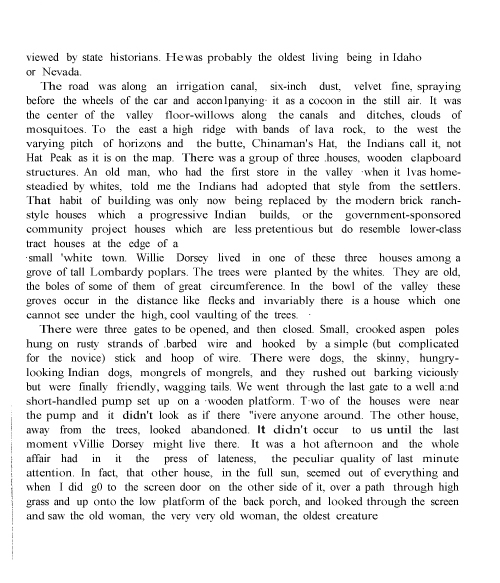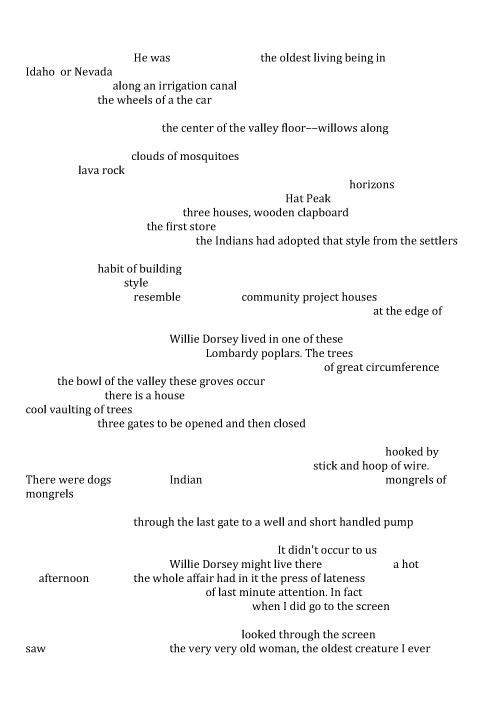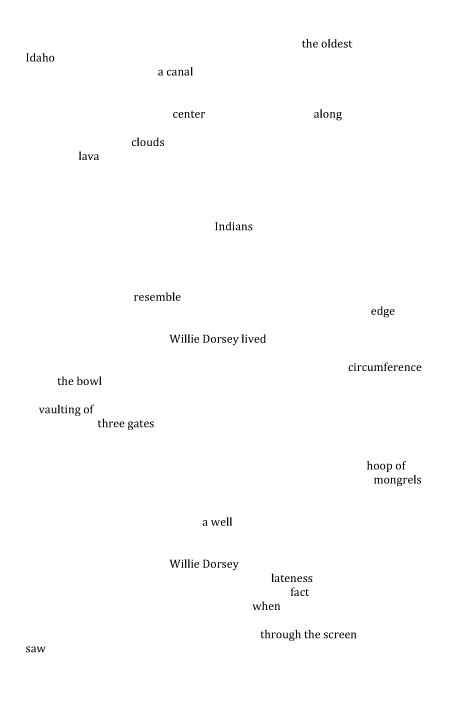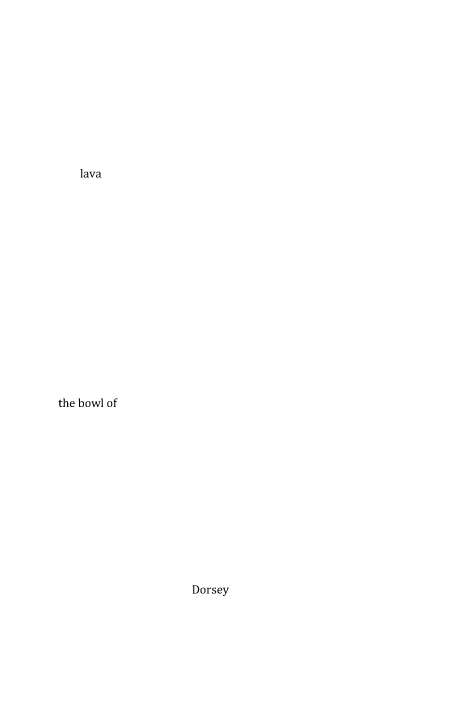This is the second installment of a three-part essay series on poetics and drought, originally delivered as a series of panel talks at the 2016 AWP conference in Los Angeles. The first is available here.
Notes Toward a Poetics of Drought
Matthew Cooperman
Drought, drouth, thirst, lack, limit, loss, unthrive, disable, disability, diss-ability. Middle English, from Old English, drugath, a dry base, a base characteristic of landscape or the interior condition of extended shortage. 1386, Chaucer: “Whan that Aprille with hise shoures soote, the droughte of Marche has perced to the roote.” 1652, Jonathan Hall: “All men naturally aim at high things and ambitiously avoid the imputation of drought or weakness.” 1666, Dryden: “As in a drought the thirsty creatures cry, And gape upon the gathered clouds for rain.” 1766, Leoni: “That burning drowth of the mind which kept you waking.” And finally 1877, L. Morris, “A secret spring of joy which mocked the drought of Fate.” (Oxford English Dictionary).
When Kristin proposed this panel I thought of course, how timely, in time for El Nino, LA AWP, the “poetics of drought,” or what have you done with my water! But then it rained, we grew distracted, watched the political sideshow churn like a hurricane. Weather patterns are all around us! Since then, of course, it’s dried up, it’s hot, hotter, “hottest on record.” In this time of degrading environments and public discourses there’s so much lack in our daily thinking that questions of sustainability might be beside the point. Drought of kindness, civility, drought of imagination, temporal recognition. It leads one to say Nature is dead, headed nowhere, not even in the news. But then just yesterday, in my electronic feed, the story of California’s Two Tunnels Project: “Decision Time Looms for Governor Brown’s 15.7 billion dollar project.” This, the largest public works project proposed in the United States in the last fifty years, would siphon water from the Sacramento River in two huge, four-story tubes––and drain the fragile California Delta––to water thirsty Angelinos for the next century. The scale and hubris boggles the mind. The poetics of drought identifies this epistemological blindness by acknowledging what’s already happened; you need a drought to imagine its poetics. Drought is late and post, a postmodern hyperobject to use Timothy Morton, endemic to the Anthropocene. And the more I think about it the more complexly drought seems to mirror a poetic practice conditioned by limits––limits as subject and object, as transaction, as temporal limit––to which we increasingly abide. The enormity of climate change makes the present, with all of its material immediacies, seem somehow blinkered to its effects. The contemporary is just that drought of perspective, a darkness visible too large to see. As Timothy Morton tells us in Ecology Without Nature:
about virtual reality––that we will be drowned in a psychotic soup
where we won’t be able to tell one thing from another––only it also
involves the possibility of our own death. It is very hard to get used
to the idea that the catastrophe, far from being imminent, has already
taken place. (28)
The paradox of this condition sufficiently captures the ethos of both my own poems, the production of my poems, and my critical interests in ecopoetics, the poetry of the west, and the interdisciplinary thinking that springs therein. How to move a hyperobject? Can, as Kristin asks, “a poetics of drought remediate environmental and cultural degradation that’s already happened?” What would that look like? What are the forms of drought’s making?
The geographer Carl Sauer said, some hundred years ago, “The thing to be known is the landscape itself; it is known by the totality of its forms.” What he meant was that definitions of landscape must include its cultural forms as much as its geologic features. Those include everyday practices of people in places, the “vernacular landscape,” as JB Jackson called it some years later. From Walmart parking lots to babbling brooks, fracking evaporation ponds to trailer parks, it is landscape’s daily uses, loses, limits, its speeches, thirsts, disturbances. To this end I think there is much to say from the perspective of the Third Landscape, Gilles Clement’s theory of liminal landscapes. Drought, disturbance, happens not only in the everyday, but in the nearby, the interstitial: medians, office parks, railroad corridors, drainage culverts, fountains. And pipes, terrain surfaces, mushroom growths, skin cells. Part of the project of replacing Nature with the ecological thought is in identifying what is always already natural with what is right next to you. Conversely, nature’s definitional inadequacy is precisely this tendency to place it out there, a quiddity of distance that abstracts such things as global warming. Whatever we want to call the world, its increasingly warm making, it’s already happening. And it occurs in the affective field of our imagining as much as the oil shales over yonder. A dry wit, an arid demeanor, the exhaustion of tears in the lyric poem, all of this is our droughty snare.
Provisional at best, then, my poetics of drought—something like My Emily Dickinson, if you’ll forgive me—is an attention to what is proximal, nearby, accessible, and to what is dynamic, in time, a daily enmeshment of people, animals and things. The limits of those things. I’ll try and trace it as both a critical and creative practice, and as both a subject (the environment out there) and a verb (the process of restructuring imagination). I have been at work on a project for some time called Whether Underground, a mixed form “almanac” of Larimer County, CO, where I live. Containing original poetry, criticism, field notes, maps, photography, undergrad and grad student essays, site-specific documentations, erasures projects and procedural gnoetries, it attempts some kind of global gist from the local imprint.
to the day
what’s the day
for or against
a pressingness or
receptivity in the
glands the mounds
of shit some
endochronology spilling out
a waterchain a single
benzene earth man
now embowered with
salt and sand an
up and down
gesture of fountaining
it’s a mineral right
by god given
a given wrong
this xylene toluene
ethyl earth man
Whether Underground collides the “science” of the controversial Glade Reservoir/NISP (Northern Integrated Supply Project) with fracking industry literature, redacted court reports, community message boards and class ethnography projects. Water, as subject leads us to its actions, in the landscape and in imagination, a cycle which eddies out into my own poems, essays, etc, and back into class projects, immersive pedagogies and surprising collaborations (mostly with my brilliant wife, the poet Aby Kaupang, who is currently the Poet Laureate of Fort Collins).
For example, I’m currently teaching a class called “About This Place” that involves ethnography, bioregionalism, and the “lure of the local,” to use art historian Lucy Lippard’s wonderful phrase. The poetics of drought enables a focus on the field, a literal field poetics. Our class lately involves a number of mapping projects working off of Denis Wood’s poetic cartographies in the book Everything Sings. As pedagogy, the poetics of drought foregrounds the material conditions of being-in-the-world, actively engaging local and bioregional landscapes with the full range of their speeches. Simple prompts like, “where does your water come from, trace it back to its source,” or “plat the surface and mineral rights of your neighborhood,” or “map the tributary movement of yourself within and without Fort Collins for a month” perform real engagement with the vernacular landscape we all inhabit.
Perhaps the most obvious principle of the poetics of drought occurs in erasure. In the “About This Place” class we’ve reading Ed Dorn’s The Shoshoneans, a groundbreaking 1966 ethnography of the Great Basin’s vanishing tribe set in one of the most arid and vast regions in North America. What’s striking is the way drought interacts not only and obviously to landscape, but to what is at the margins of that landscape. Dorn’s white intrusion into the “marginal Indians” of the Shoshone Tribes of Nevada, is accompanied by haunting photographs by the African-American photographer Leroy Lucas. Picture a white, long-haired poet and a black afro’d photographer cruising around the Great Basin in a beater car picking up Indian hitchhikers a year after Malcolm X is assassinated. Drought is who is lacking, on the outs, needs a ride, could use a drink. With little to lose the droughtist is radically open. Dorn and Lucas are outsiders, drifters, nomads who gain entrance into the world of the Shoshone precisely by their marginalization. By a process of identification, the poetics of drought operates on the natural and cultural ecotones of their wanderings up and down that most arterial American fact: the highway. Working off Dorn’s model of a bioregion, I’ve been performing erasures on the text as a material aridification. Sequence, inhabitation, interrelation, objectification all get distilled in this erasure project. Here’s an excerpt fr. S H O H N E N S:




As a formal gesture drought also functions as a limit, and interest in limits as procedural and existential demands, as in my recently published book Spool, with its three word counted-verse. Begun as a practical matter of journal space, it became an allegory of limits, boundaries, in our raising of our autistic daughter Maya. In this way drought, unthrive, pressures syntax as an act of witness for a speechless daughter.
From Spool:
year in threes
these little wiles
and pauses what
they bring to
doorsteps planets terns
at the window
on my mind
limit is splendor
bright folds now
love or parenting
the time it
loses or looses
indelible hows plotting
the new child
the better man
bird in hand
bonus weir like
a line singing
makes a limit
out of days
slowly the dark
an imperfect finity
forever in time
these nights splendor
As I’ve said I see drought as both a subject and verb. To drought, to limit, to dry, or, like water, to pool, eddy, ebb and flow. And if there is an evaporative process of erasure to its making, there’s also the release to chance. Here’s a snippet of a gnoetry procedure on fracking reports, from Whether Underground:
Deficit holes for arsenic drillers
Spontaneous practice tested near a goat
Trade secrets legal that lubricant rub
Of mortals a coil of metals in wells
That phenol abortion sensory extreme
Heavy near drillers for even the horse
Spontaneous poisoning for wastewater spread
Extreme deicing of dust farming roads
Heavy metal nosebleed tested the drillers
Spontaneous arsenic considered in schools
I’m also interested in the idea of a disabled landscape, the intersections of drought with disability studies, a variant of thirst for visibility, access, voice. Third Landscape theory suggests the liminal zone as both the area of most disturbance, but also the zone with the greatest biotic diversity. The forgotten, the unseen, the abject, how might they hold a reservoir of empathy, how might they Abilify, to use the euphemism of an awful drug, the agency of the Other. This work springs largely from Aby’s and my experience raising our daughter Maya. She doesn’t speak, she doesn’t eat by mouth, she doesn’t sleep much, but she is a powerful environmental agent. Or rather agent and symptom, a child alive through modern medicine. From the constructed landscape of the modern hospital to the venous circuitry of the body through which she eats, by G-tube, to the conditions of the modern waterchain, and its dramatic infiltration by discarded pharmaceuticals—and I would only point to the ecological tragedy of Flint, MI to suggest a pervasive corruption of our water systems—to the mountain of diapers we are constructing like some disability Watts Tower, the poetics of drought can be seen in the disabled body. And what does the othered body thirst after? What lack in speech or physical access, or excess, of lead, pharmaceuticals, unwires us in a dry season? Xeric, dry, unattended, unirrigated, unseen, unheard. Protest movements like Occupy and Black Lives Matter intersect with disability studies in just this drought of imagination. What will the future hold?
I am particularly moved by—and am working on—the writing of the poet Larry Eigner. The physical limit of his cerebral palsy was tremendous; he typed all of his mature work on a 1940 Royal typewriter using only his right index finger and thumb. Nevertheless he produced an enormous body of poignant, ecologically-attuned poetry that has much to teach us about our interconnected world (see Stanford Press’s 4-volume Collected). Writing largely inside his Berkeley apartment, Eigner’s drowth manages a most profound extension to the out of doors, a sidereal expression of Projective Verse that dramatically expands Olson’s theory. Not a speech-based poetics, Eigner’s projectivity occurs in its thinking, in its capacity to extend itself from the self. It also gains weight through its queer alignment , its doubly-othered subject who profoundly expands, within limits again, the intersubjectivity of its disability. Here’s a passage from his last book readiness / enough depends / on:
when it does you don’t
know what time it is
never mind
ah various
intersections
all bounds
aries keeps on
In more general terms, of course, drought means water, or lack of it. For that reasons I’m at base always interested in the Cache La Poudre River that runs through Fort Collins, and its fate as a western river. Already designated a Wild and Scenic River by President Clinton, the Poudre remains the target of the Army Corp of Engineers nevertheless. The river is the spirit of the city, and its possible damning represents the drought of imagination that would diminish the reason you or I live here, and not there. The phrase going up the Poudre, which means driving up the nearly 100-mile canyon to go rafting, fishing, hiking, meditating, picnicing, clearly carries the fate of the region if the dam goes through. But the Poudre’s story is the story of the West, of a deliberate misreading of resources and landscapes, the agrarian hubris of Manifest Destiny. “You just have to dig for wood and water!,” crows Horace Greeley. More geographically, then, the poetics of drought is a western poetics, a sustainable making of the arid places, the dry horizon, a counterforce of margin by which to evaporate the agricultural agenda of Manifest Destiny.
I’ll end on a capillary note: rivers and lakes are the ostensible circulation system of any inland landscape, the presiding figure of health. To perform a little stitchery to this panel, and its genuinely California focus with these fine poets, I’ll thread my place to your place. As in the headwaters of the Colorado River begin in Rocky Mountain National Park, a mere stone’s throw from Fort Collins. As in, the Colorado River, while not huge by flow or distance, has been called “intrinsically the most valuable stream in the world, ” irrigating nearly forty million people in seven states, with an economy larger than Germany. Its use and misuse alone marks a poetics of drought, “A secret spring of [false] joy which mocks the drought of Fate.” By an over allocation of uses and a paucity of imagination, the Colorado River dribbles its way to this very city of Los Angeles. It increasingly will do so in the coming century as Phoenix, Tucson, Las Vegas, San Diego and L.A. drink it dry. By my headwaters I ask you Californians to abide the poetics of drought and change your ways!! As William Carlos Willliams said, attending his river in Paterson, “Who because they neither know their sources nor the sills of their disappointments walk outside their bodies aimlessly”
Works Cited
Clement, Giles. “The Third Landscape.” http://www.gillesclement.com/art-454-tit-The-Third-Landscape
Cooperman, Matthew. Spool. Clemson: Anderson, South Carolina: Parlor Press, 2016.
Dorn, Ed. The Shoshoneans: The People of the Basin Plateau. Photographs, Leroy Lucas. Expanded Edition, ed. Matthew Hofer. Albuquerque: University of New Mexico Press, 2013.
Eigner, Larry. readiness /enough /depends on. Los Angeles: Green Integer, 2000.
—–. The Collected Poems of Larry Eigner. Palo Alto: Stanford University Press, 2010.
Jackson, J.B. A Sense of Place, A Sense of Time. New Haven, CT: Yale University Press, 1996.
Lippard, Lucy. The Lure of the Local: Senses of Place in a Multicentered Society. New York: The New Press, 1998.
Morton, Timothy. The Ecological Thought. Boston: Harvard University Press, 2012.
Murray, J.A.H. The Compact Edition of the Oxford English Dictionary. Oxford, England: Oxford University Press, 1971.
—–. Ecology Without Nature: Rethinking Environmental Aesthetics. Boston: Harvard University Press, 2009.
Owen, David. “Where the River Runs Dry: The Colorado and America’s Water Crisis,”
The New Yorker, May 25, 2015.
Sauer, Carl Ortwin. Land and Life: The Selected Writings of Carl O. Sauer. Berkeley: University of California Press, 1967.
Williams, William Carlos. Paterson. New York: New Directions, 1963
Wood, Denis. Everything Sings: Maps for a Narrative Atlas. Los Angeles: Siglio Editions, 2013.